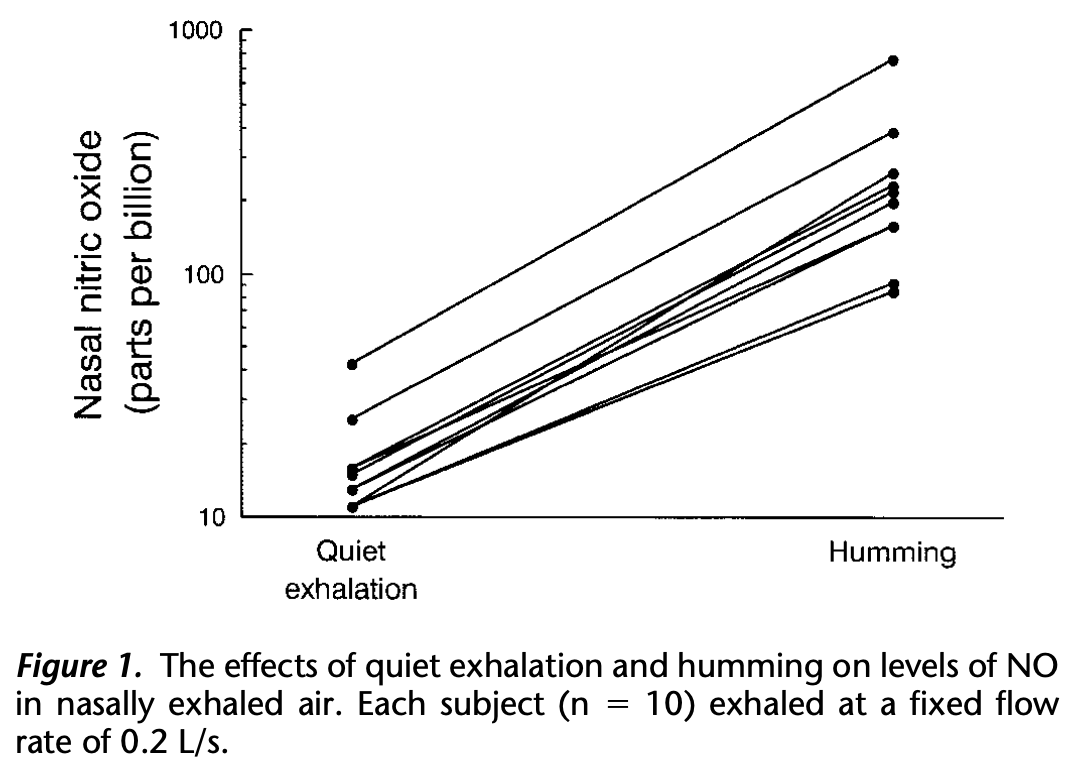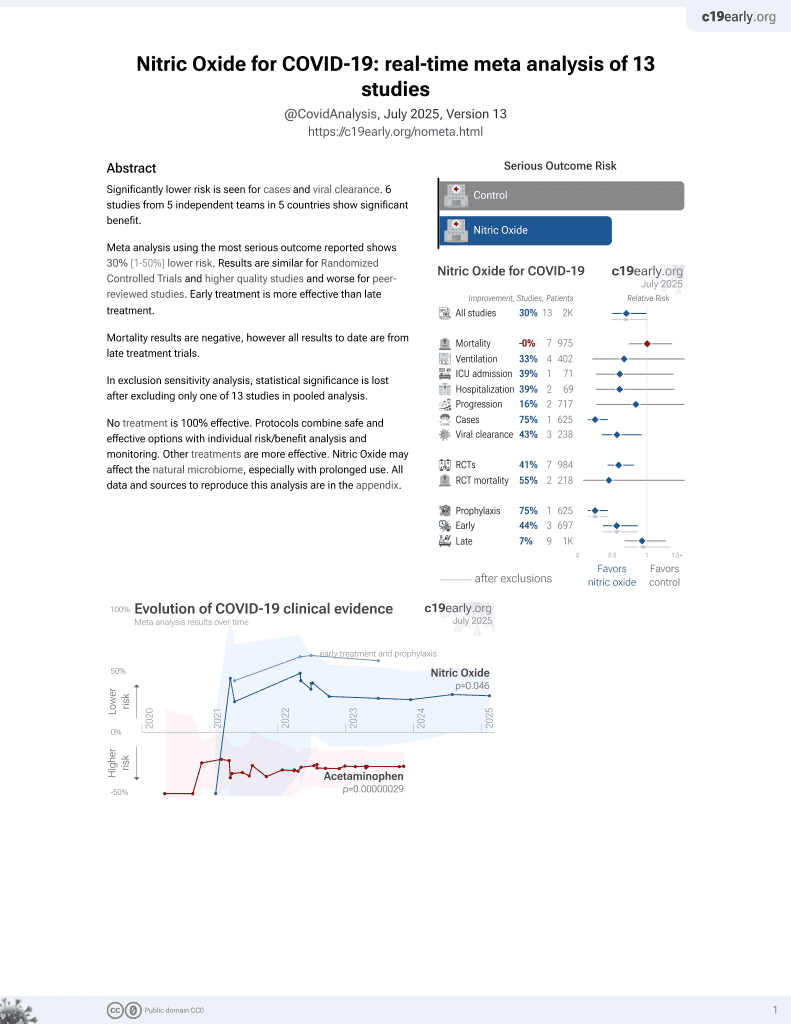
Humming Greatly Increases Nasal Nitric Oxide
et al., American Journal of Respiratory and Critical Care Medicine, doi:10.1164/rccm.200202-138BC, Jul 2002
42nd treatment shown to reduce risk in
June 2022, now with p = 0.012 from 12 studies, recognized in 10 countries.
Lower risk for cases and viral clearance.
No treatment is 100% effective. Protocols
combine treatments.
6,300+ studies for
210+ treatments. c19early.org
|
Study of 10 healthy subjects showing that humming increased nasal nitric oxide (NO) levels 15 fold compared to quiet exhalation, likely due to increased sinus ventilation and gas exchange between the sinuses and nasal cavity. In a two-compartment model resembling the nasal cavity and sinuses, oscillating airflow from phonation dramatically increased gas exchange between the compartments.
Weitzberg et al., 15 Jul 2002, peer-reviewed, 2 authors.
Humming Greatly Increases Nasal Nitric Oxide
American Journal of Respiratory and Critical Care Medicine, doi:10.1164/rccm.200202-138bc
The paranasal sinuses are major producers of nitric oxide (NO). We hypothesized that oscillating airflow produced by humming would enhance sinus ventilation and thereby increase nasal NO levels. Ten healthy subjects took part in the study. Nasal NO was measured with a chemiluminescence technique during humming and quiet single-breath exhalations at a fixed flow rate. NO increased 15-fold during humming compared with quiet exhalation. In a two-compartment model of the nose and sinus, oscillating airflow caused a dramatic increase in gas exchange between the cavities. Obstruction of the sinus ostium is a central event in the pathogenesis of sinusitis. Nasal NO measurements during humming may be a useful noninvasive test of sinus NO production and ostial patency. In addition, any therapeutic effects of the improved sinus ventilation caused by humming should be investigated.
References
Aust, Drettner, The functional size of the human maxillary ostium in vivo, Acta Otolaryngol
Kaliner, Osguthorpe, Fireman, Anon, Georgitis et al., Sinusitis: bench to bedside: current findings, future directions, J Allergy Clin Immunol
Lundberg, Farkas-Szallasi, Weitzberg, Rinder, Lidholm et al., High nitric oxide production in human paranasal sinuses, Nat Med
Lundberg, Weitzberg, Nasal nitric oxide in man, Thorax
Thoracic, Recommendations for standardized procedures for the online and offline measurement of exhaled lower respiratory nitric oxide and nasal nitric oxide in adults and children, Am J Respir Crit Care Med
DOI record:
{
"DOI": "10.1164/rccm.200202-138bc",
"ISSN": [
"1073-449X",
"1535-4970"
],
"URL": "http://dx.doi.org/10.1164/rccm.200202-138BC",
"alternative-id": [
"10.1164/rccm.200202-138BC"
],
"author": [
{
"affiliation": [
{
"name": "Department of Anesthesiology and Intensive Care, Karolinska Hospital, and Department of Physiology and Pharmacology, Karolinska Institutet, Stockholm, Sweden"
}
],
"family": "Weitzberg",
"given": "Eddie",
"sequence": "first"
},
{
"affiliation": [
{
"name": "Department of Anesthesiology and Intensive Care, Karolinska Hospital, and Department of Physiology and Pharmacology, Karolinska Institutet, Stockholm, Sweden"
}
],
"family": "Lundberg",
"given": "Jon O. N.",
"sequence": "additional"
}
],
"container-title": "American Journal of Respiratory and Critical Care Medicine",
"container-title-short": "Am J Respir Crit Care Med",
"content-domain": {
"crossmark-restriction": false,
"domain": []
},
"created": {
"date-parts": [
[
2002,
7,
28
]
],
"date-time": "2002-07-28T23:17:19Z",
"timestamp": 1027898239000
},
"deposited": {
"date-parts": [
[
2022,
7,
15
]
],
"date-time": "2022-07-15T11:26:22Z",
"timestamp": 1657884382000
},
"indexed": {
"date-parts": [
[
2023,
12,
29
]
],
"date-time": "2023-12-29T18:00:50Z",
"timestamp": 1703872850003
},
"is-referenced-by-count": 94,
"issue": "2",
"issued": {
"date-parts": [
[
2002,
7,
15
]
]
},
"journal-issue": {
"issue": "2",
"published-print": {
"date-parts": [
[
2002,
7,
15
]
]
}
},
"language": "en",
"link": [
{
"URL": "https://www.atsjournals.org/doi/pdf/10.1164/rccm.200202-138BC",
"content-type": "unspecified",
"content-version": "vor",
"intended-application": "similarity-checking"
}
],
"member": "19",
"original-title": [],
"page": "144-145",
"prefix": "10.1164",
"published": {
"date-parts": [
[
2002,
7,
15
]
]
},
"published-print": {
"date-parts": [
[
2002,
7,
15
]
]
},
"publisher": "American Thoracic Society",
"reference": [
{
"DOI": "10.1136/thx.54.10.947",
"doi-asserted-by": "publisher",
"key": "BIB1"
},
{
"DOI": "10.1038/nm0495-370",
"doi-asserted-by": "publisher",
"key": "BIB2"
},
{
"DOI": "10.3109/00016487409126376",
"doi-asserted-by": "crossref",
"key": "BIB3",
"unstructured": "Aust R, Drettner B. The functional size of the human maxillary ostium in vivo. Acta Otolaryngol 1975;78:432–435."
},
{
"DOI": "10.1016/S0091-6749(97)70041-1",
"doi-asserted-by": "crossref",
"key": "BIB4",
"unstructured": "Kaliner MA, Osguthorpe JD, Fireman P, Anon J, Georgitis J, Davis ML, Naclerio R, Kennedy D. Sinusitis: bench to bedside: current findings, future directions. J Allergy Clin Immunol 1997;99:S829–S848."
},
{
"DOI": "10.1164/ajrccm.160.6.ats8-99",
"doi-asserted-by": "publisher",
"key": "BIB5"
}
],
"reference-count": 5,
"references-count": 5,
"relation": {},
"resource": {
"primary": {
"URL": "https://www.atsjournals.org/doi/10.1164/rccm.200202-138BC"
}
},
"score": 1,
"short-title": [],
"source": "Crossref",
"subject": [
"Critical Care and Intensive Care Medicine",
"Pulmonary and Respiratory Medicine"
],
"subtitle": [],
"title": "Humming Greatly Increases Nasal Nitric Oxide",
"type": "journal-article",
"volume": "166"
}
